BMSW4003 Digital Skills Research: Moodle Impact on Student Learning
VerifiedAdded on 2023/01/16
|30
|3749
|22
Report
AI Summary
This research report investigates the impact of the Moodle virtual learning environment (VLE) on students at the University of Wales-Trinity Saint David, London Campus. The study examines the concept of virtual learning, its effects on students, and employs both primary and secondary research methods, including a questionnaire administered to 30 students. The report outlines the methodology, ethical considerations, and presents the results, analyzing student responses regarding Moodle's ease of use, information availability, impact on learning, and the need for computing skills and training. The findings, presented through frequency tables and interpretations, reveal student perceptions of Moodle's effectiveness and its role in their learning experiences. The report also discusses the limitations of the study and concludes with an overview of the key findings regarding Moodle's impact on students' digital skills and learning outcomes.
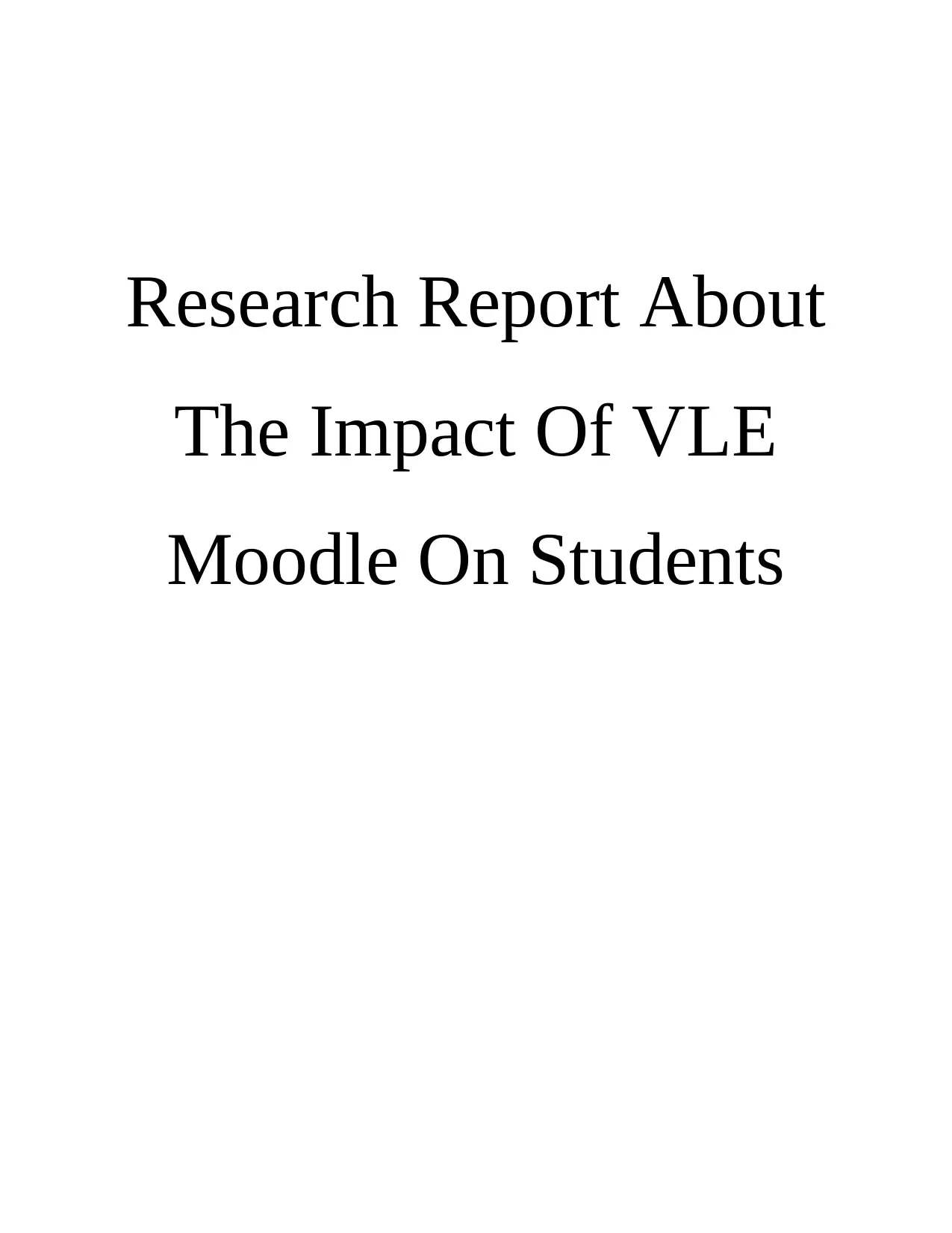
Research Report About
The Impact Of VLE
Moodle On Students
The Impact Of VLE
Moodle On Students
Paraphrase This Document
Need a fresh take? Get an instant paraphrase of this document with our AI Paraphraser
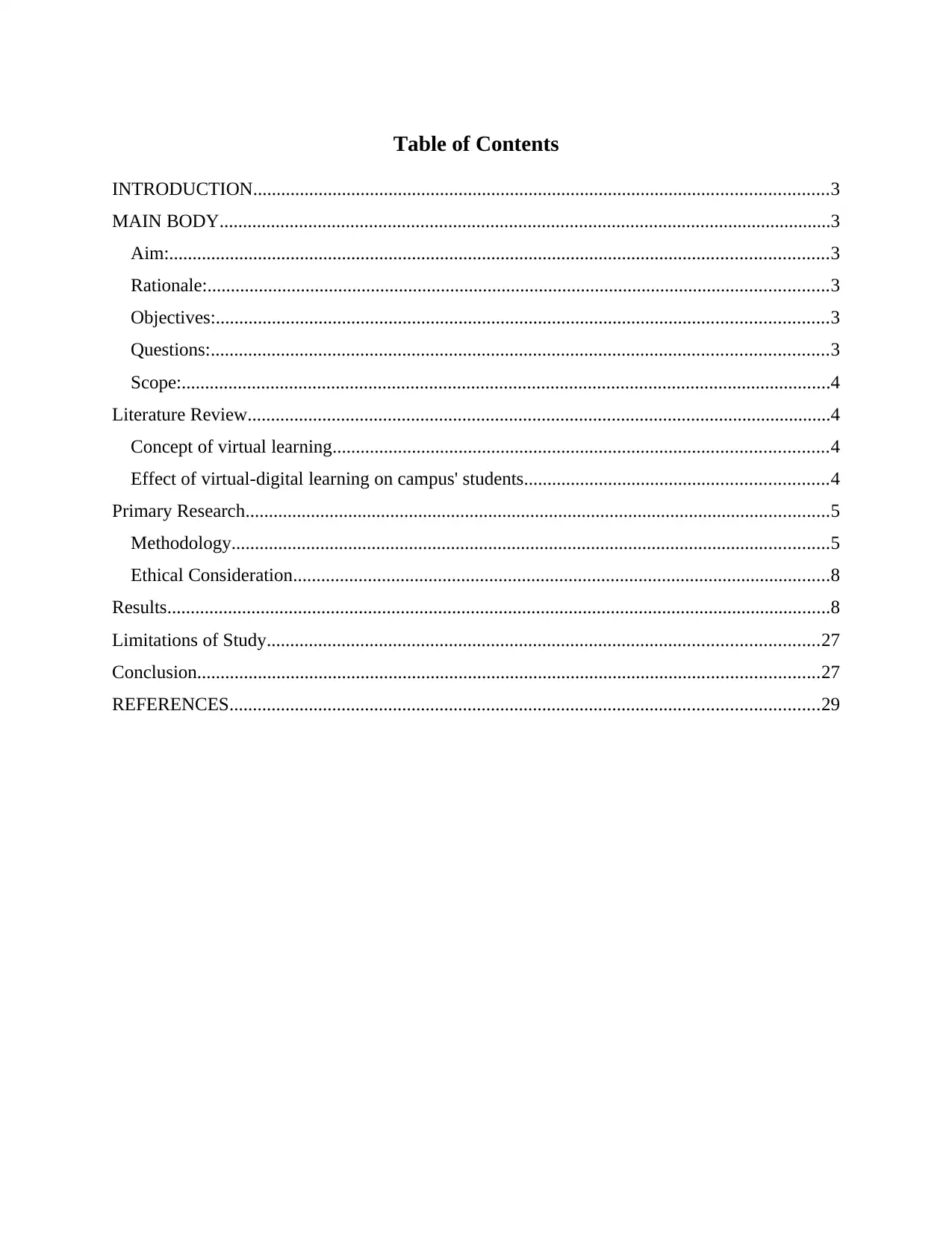
Table of Contents
INTRODUCTION...........................................................................................................................3
MAIN BODY...................................................................................................................................3
Aim:.............................................................................................................................................3
Rationale:.....................................................................................................................................3
Objectives:...................................................................................................................................3
Questions:....................................................................................................................................3
Scope:...........................................................................................................................................4
Literature Review.............................................................................................................................4
Concept of virtual learning..........................................................................................................4
Effect of virtual-digital learning on campus' students.................................................................4
Primary Research.............................................................................................................................5
Methodology................................................................................................................................5
Ethical Consideration...................................................................................................................8
Results..............................................................................................................................................8
Limitations of Study......................................................................................................................27
Conclusion.....................................................................................................................................27
REFERENCES..............................................................................................................................29
INTRODUCTION...........................................................................................................................3
MAIN BODY...................................................................................................................................3
Aim:.............................................................................................................................................3
Rationale:.....................................................................................................................................3
Objectives:...................................................................................................................................3
Questions:....................................................................................................................................3
Scope:...........................................................................................................................................4
Literature Review.............................................................................................................................4
Concept of virtual learning..........................................................................................................4
Effect of virtual-digital learning on campus' students.................................................................4
Primary Research.............................................................................................................................5
Methodology................................................................................................................................5
Ethical Consideration...................................................................................................................8
Results..............................................................................................................................................8
Limitations of Study......................................................................................................................27
Conclusion.....................................................................................................................................27
REFERENCES..............................................................................................................................29
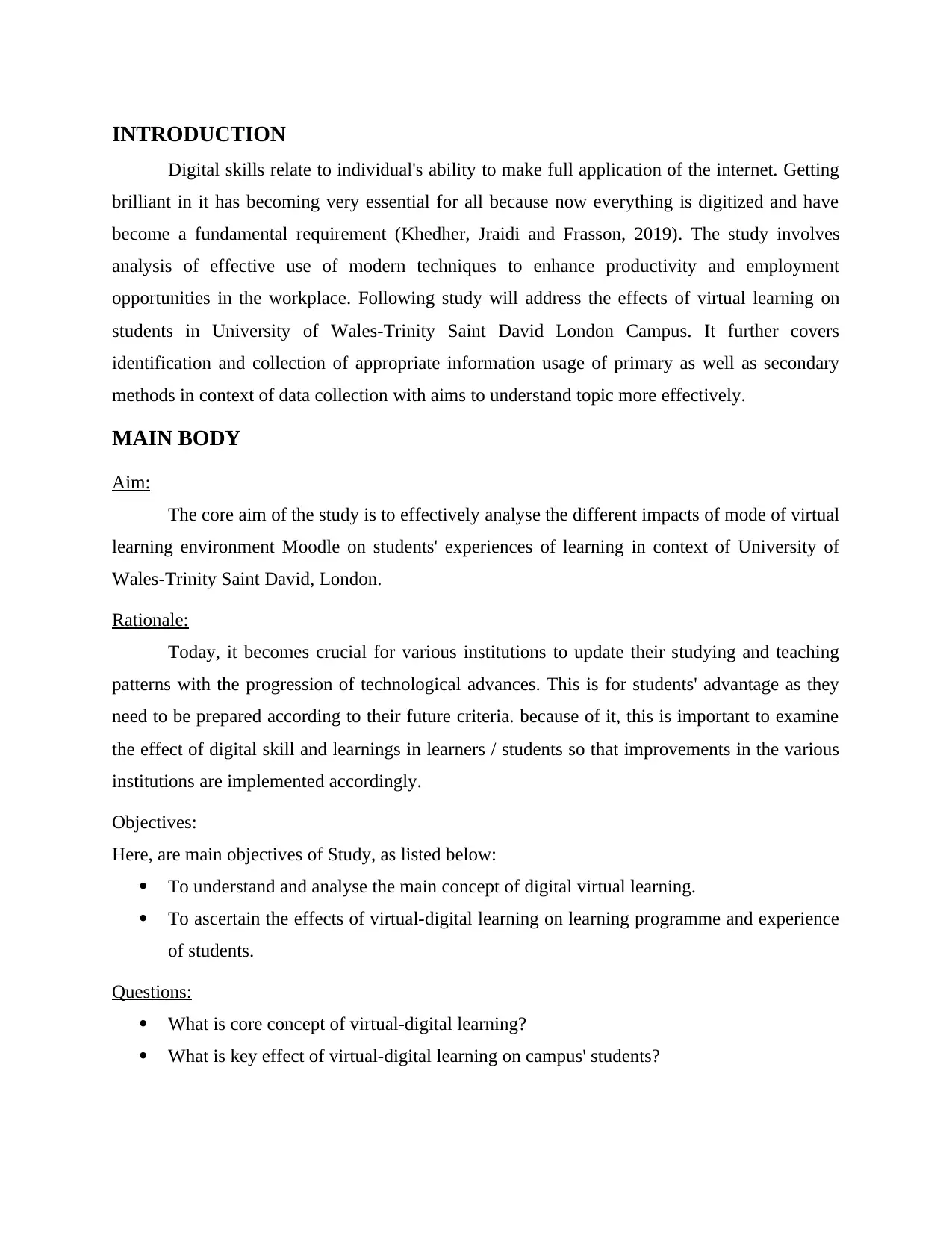
INTRODUCTION
Digital skills relate to individual's ability to make full application of the internet. Getting
brilliant in it has becoming very essential for all because now everything is digitized and have
become a fundamental requirement (Khedher, Jraidi and Frasson, 2019). The study involves
analysis of effective use of modern techniques to enhance productivity and employment
opportunities in the workplace. Following study will address the effects of virtual learning on
students in University of Wales-Trinity Saint David London Campus. It further covers
identification and collection of appropriate information usage of primary as well as secondary
methods in context of data collection with aims to understand topic more effectively.
MAIN BODY
Aim:
The core aim of the study is to effectively analyse the different impacts of mode of virtual
learning environment Moodle on students' experiences of learning in context of University of
Wales-Trinity Saint David, London.
Rationale:
Today, it becomes crucial for various institutions to update their studying and teaching
patterns with the progression of technological advances. This is for students' advantage as they
need to be prepared according to their future criteria. because of it, this is important to examine
the effect of digital skill and learnings in learners / students so that improvements in the various
institutions are implemented accordingly.
Objectives:
Here, are main objectives of Study, as listed below:
To understand and analyse the main concept of digital virtual learning.
To ascertain the effects of virtual-digital learning on learning programme and experience
of students.
Questions:
What is core concept of virtual-digital learning?
What is key effect of virtual-digital learning on campus' students?
Digital skills relate to individual's ability to make full application of the internet. Getting
brilliant in it has becoming very essential for all because now everything is digitized and have
become a fundamental requirement (Khedher, Jraidi and Frasson, 2019). The study involves
analysis of effective use of modern techniques to enhance productivity and employment
opportunities in the workplace. Following study will address the effects of virtual learning on
students in University of Wales-Trinity Saint David London Campus. It further covers
identification and collection of appropriate information usage of primary as well as secondary
methods in context of data collection with aims to understand topic more effectively.
MAIN BODY
Aim:
The core aim of the study is to effectively analyse the different impacts of mode of virtual
learning environment Moodle on students' experiences of learning in context of University of
Wales-Trinity Saint David, London.
Rationale:
Today, it becomes crucial for various institutions to update their studying and teaching
patterns with the progression of technological advances. This is for students' advantage as they
need to be prepared according to their future criteria. because of it, this is important to examine
the effect of digital skill and learnings in learners / students so that improvements in the various
institutions are implemented accordingly.
Objectives:
Here, are main objectives of Study, as listed below:
To understand and analyse the main concept of digital virtual learning.
To ascertain the effects of virtual-digital learning on learning programme and experience
of students.
Questions:
What is core concept of virtual-digital learning?
What is key effect of virtual-digital learning on campus' students?
⊘ This is a preview!⊘
Do you want full access?
Subscribe today to unlock all pages.

Trusted by 1+ million students worldwide
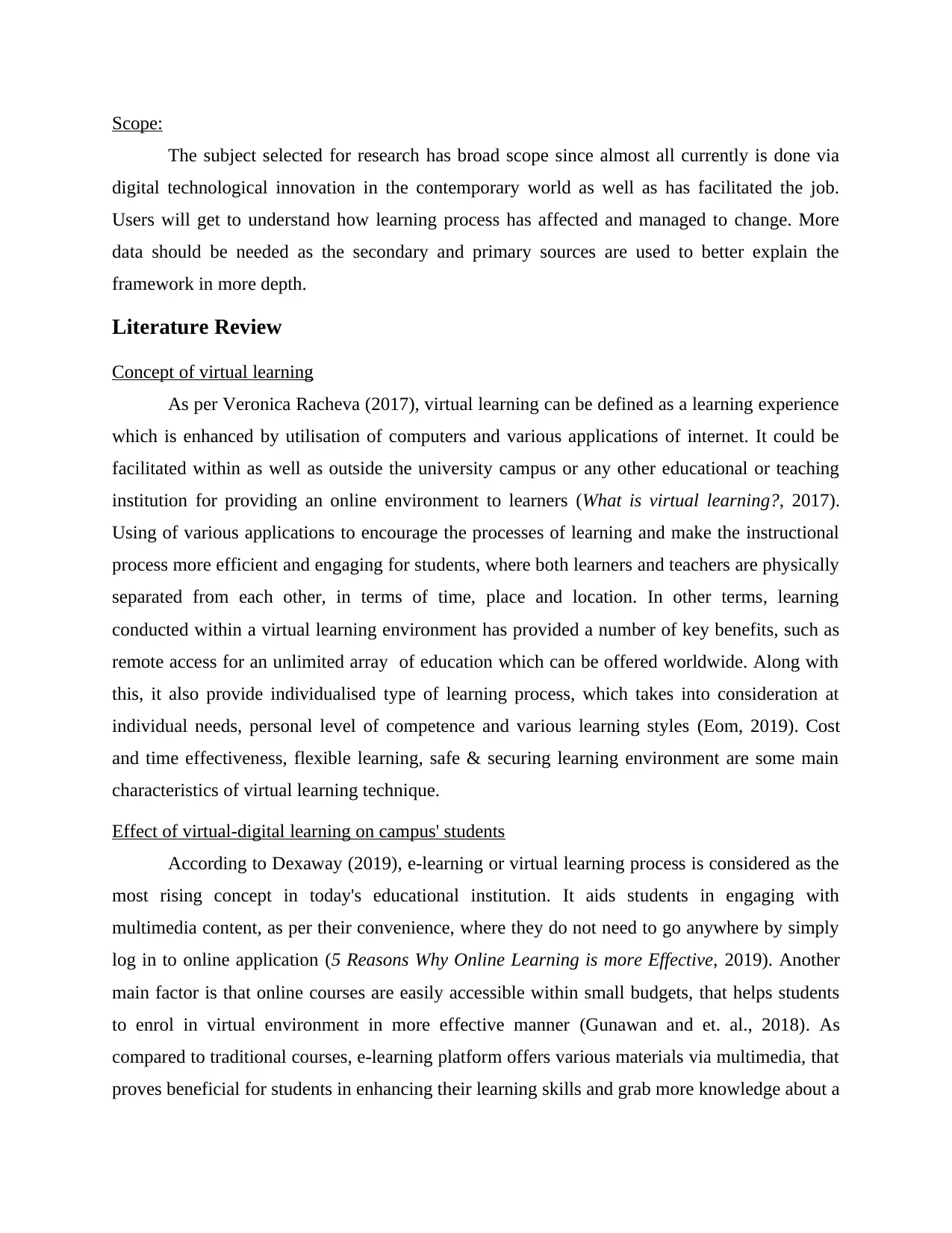
Scope:
The subject selected for research has broad scope since almost all currently is done via
digital technological innovation in the contemporary world as well as has facilitated the job.
Users will get to understand how learning process has affected and managed to change. More
data should be needed as the secondary and primary sources are used to better explain the
framework in more depth.
Literature Review
Concept of virtual learning
As per Veronica Racheva (2017), virtual learning can be defined as a learning experience
which is enhanced by utilisation of computers and various applications of internet. It could be
facilitated within as well as outside the university campus or any other educational or teaching
institution for providing an online environment to learners (What is virtual learning?, 2017).
Using of various applications to encourage the processes of learning and make the instructional
process more efficient and engaging for students, where both learners and teachers are physically
separated from each other, in terms of time, place and location. In other terms, learning
conducted within a virtual learning environment has provided a number of key benefits, such as
remote access for an unlimited array of education which can be offered worldwide. Along with
this, it also provide individualised type of learning process, which takes into consideration at
individual needs, personal level of competence and various learning styles (Eom, 2019). Cost
and time effectiveness, flexible learning, safe & securing learning environment are some main
characteristics of virtual learning technique.
Effect of virtual-digital learning on campus' students
According to Dexaway (2019), e-learning or virtual learning process is considered as the
most rising concept in today's educational institution. It aids students in engaging with
multimedia content, as per their convenience, where they do not need to go anywhere by simply
log in to online application (5 Reasons Why Online Learning is more Effective, 2019). Another
main factor is that online courses are easily accessible within small budgets, that helps students
to enrol in virtual environment in more effective manner (Gunawan and et. al., 2018). As
compared to traditional courses, e-learning platform offers various materials via multimedia, that
proves beneficial for students in enhancing their learning skills and grab more knowledge about a
The subject selected for research has broad scope since almost all currently is done via
digital technological innovation in the contemporary world as well as has facilitated the job.
Users will get to understand how learning process has affected and managed to change. More
data should be needed as the secondary and primary sources are used to better explain the
framework in more depth.
Literature Review
Concept of virtual learning
As per Veronica Racheva (2017), virtual learning can be defined as a learning experience
which is enhanced by utilisation of computers and various applications of internet. It could be
facilitated within as well as outside the university campus or any other educational or teaching
institution for providing an online environment to learners (What is virtual learning?, 2017).
Using of various applications to encourage the processes of learning and make the instructional
process more efficient and engaging for students, where both learners and teachers are physically
separated from each other, in terms of time, place and location. In other terms, learning
conducted within a virtual learning environment has provided a number of key benefits, such as
remote access for an unlimited array of education which can be offered worldwide. Along with
this, it also provide individualised type of learning process, which takes into consideration at
individual needs, personal level of competence and various learning styles (Eom, 2019). Cost
and time effectiveness, flexible learning, safe & securing learning environment are some main
characteristics of virtual learning technique.
Effect of virtual-digital learning on campus' students
According to Dexaway (2019), e-learning or virtual learning process is considered as the
most rising concept in today's educational institution. It aids students in engaging with
multimedia content, as per their convenience, where they do not need to go anywhere by simply
log in to online application (5 Reasons Why Online Learning is more Effective, 2019). Another
main factor is that online courses are easily accessible within small budgets, that helps students
to enrol in virtual environment in more effective manner (Gunawan and et. al., 2018). As
compared to traditional courses, e-learning platform offers various materials via multimedia, that
proves beneficial for students in enhancing their learning skills and grab more knowledge about a
Paraphrase This Document
Need a fresh take? Get an instant paraphrase of this document with our AI Paraphraser
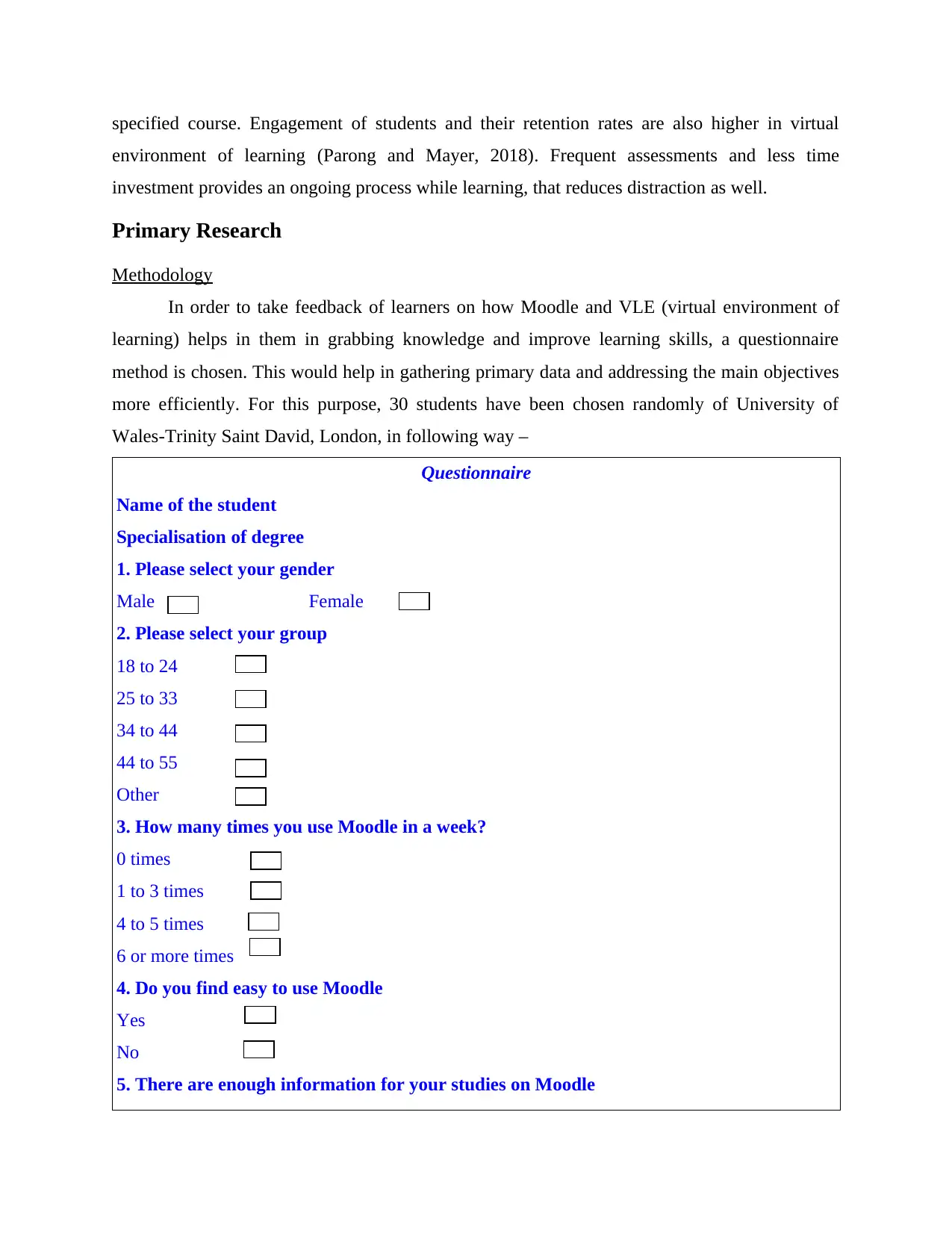
specified course. Engagement of students and their retention rates are also higher in virtual
environment of learning (Parong and Mayer, 2018). Frequent assessments and less time
investment provides an ongoing process while learning, that reduces distraction as well.
Primary Research
Methodology
In order to take feedback of learners on how Moodle and VLE (virtual environment of
learning) helps in them in grabbing knowledge and improve learning skills, a questionnaire
method is chosen. This would help in gathering primary data and addressing the main objectives
more efficiently. For this purpose, 30 students have been chosen randomly of University of
Wales-Trinity Saint David, London, in following way –
Questionnaire
Name of the student
Specialisation of degree
1. Please select your gender
Male Female
2. Please select your group
18 to 24
25 to 33
34 to 44
44 to 55
Other
3. How many times you use Moodle in a week?
0 times
1 to 3 times
4 to 5 times
6 or more times
4. Do you find easy to use Moodle
Yes
No
5. There are enough information for your studies on Moodle
environment of learning (Parong and Mayer, 2018). Frequent assessments and less time
investment provides an ongoing process while learning, that reduces distraction as well.
Primary Research
Methodology
In order to take feedback of learners on how Moodle and VLE (virtual environment of
learning) helps in them in grabbing knowledge and improve learning skills, a questionnaire
method is chosen. This would help in gathering primary data and addressing the main objectives
more efficiently. For this purpose, 30 students have been chosen randomly of University of
Wales-Trinity Saint David, London, in following way –
Questionnaire
Name of the student
Specialisation of degree
1. Please select your gender
Male Female
2. Please select your group
18 to 24
25 to 33
34 to 44
44 to 55
Other
3. How many times you use Moodle in a week?
0 times
1 to 3 times
4 to 5 times
6 or more times
4. Do you find easy to use Moodle
Yes
No
5. There are enough information for your studies on Moodle
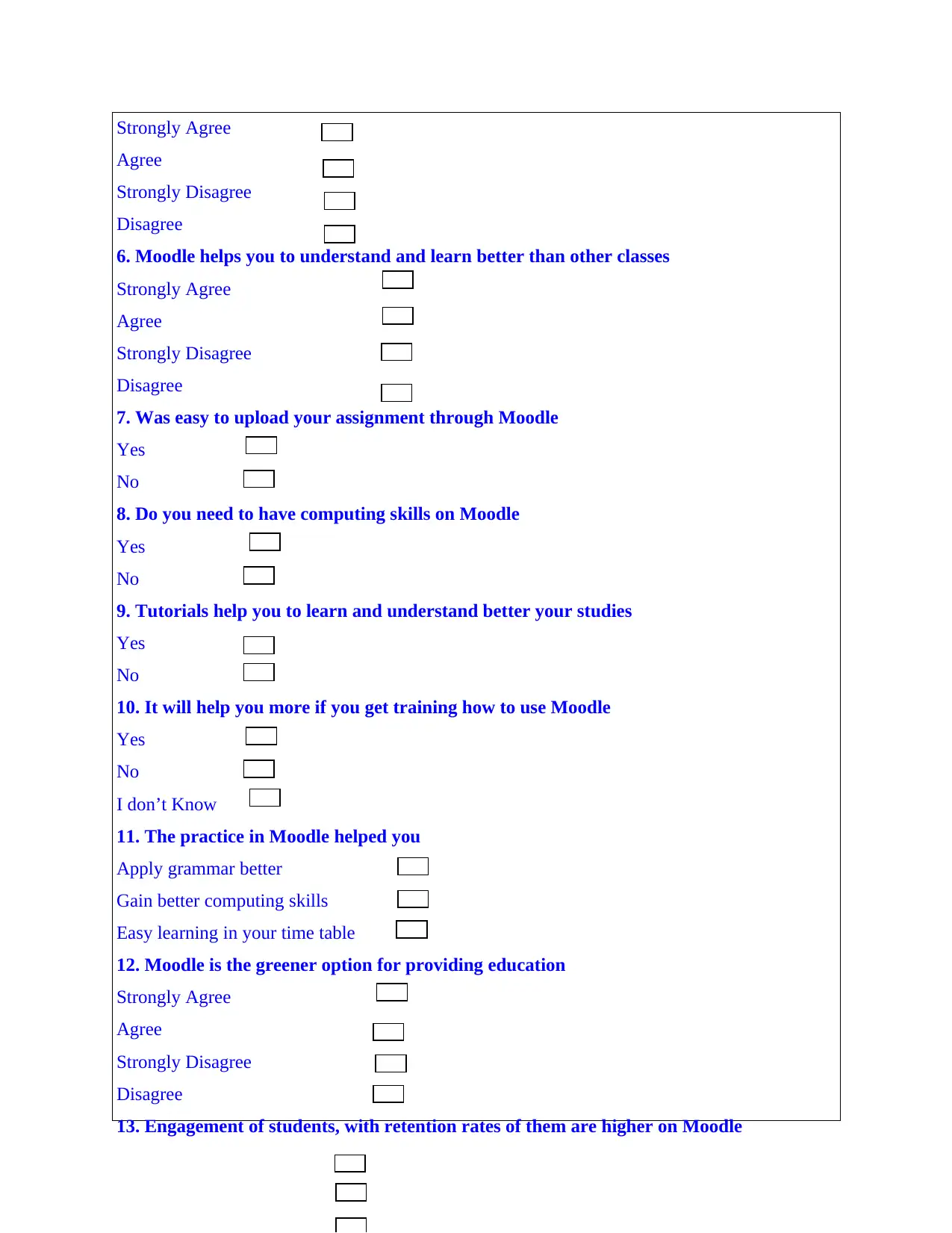
Strongly Agree
Agree
Strongly Disagree
Disagree
6. Moodle helps you to understand and learn better than other classes
Strongly Agree
Agree
Strongly Disagree
Disagree
7. Was easy to upload your assignment through Moodle
Yes
No
8. Do you need to have computing skills on Moodle
Yes
No
9. Tutorials help you to learn and understand better your studies
Yes
No
10. It will help you more if you get training how to use Moodle
Yes
No
I don’t Know
11. The practice in Moodle helped you
Apply grammar better
Gain better computing skills
Easy learning in your time table
12. Moodle is the greener option for providing education
Strongly Agree
Agree
Strongly Disagree
Disagree
13. Engagement of students, with retention rates of them are higher on Moodle
Agree
Strongly Disagree
Disagree
6. Moodle helps you to understand and learn better than other classes
Strongly Agree
Agree
Strongly Disagree
Disagree
7. Was easy to upload your assignment through Moodle
Yes
No
8. Do you need to have computing skills on Moodle
Yes
No
9. Tutorials help you to learn and understand better your studies
Yes
No
10. It will help you more if you get training how to use Moodle
Yes
No
I don’t Know
11. The practice in Moodle helped you
Apply grammar better
Gain better computing skills
Easy learning in your time table
12. Moodle is the greener option for providing education
Strongly Agree
Agree
Strongly Disagree
Disagree
13. Engagement of students, with retention rates of them are higher on Moodle
⊘ This is a preview!⊘
Do you want full access?
Subscribe today to unlock all pages.

Trusted by 1+ million students worldwide
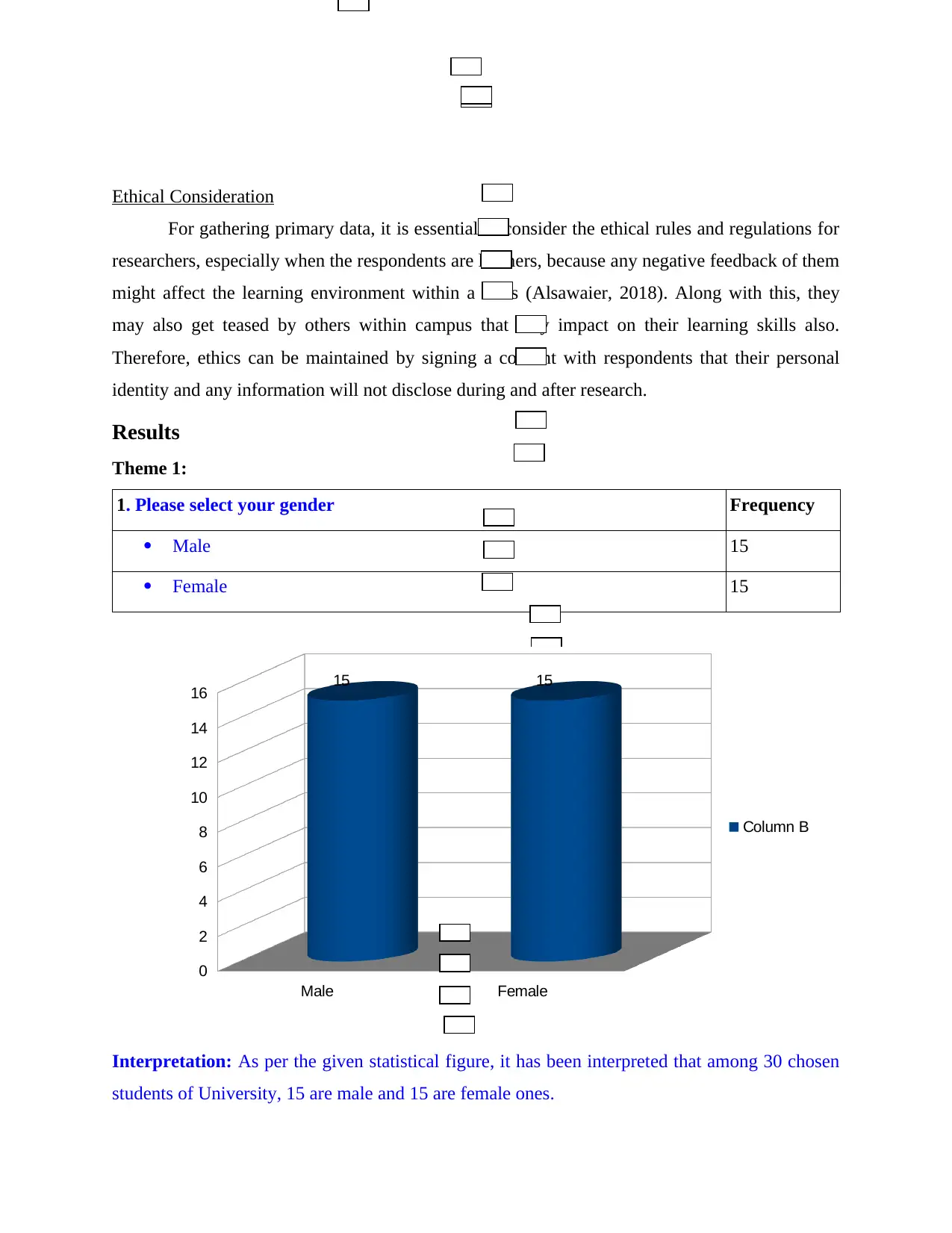
Ethical Consideration
For gathering primary data, it is essential to consider the ethical rules and regulations for
researchers, especially when the respondents are learners, because any negative feedback of them
might affect the learning environment within a class (Alsawaier, 2018). Along with this, they
may also get teased by others within campus that may impact on their learning skills also.
Therefore, ethics can be maintained by signing a consent with respondents that their personal
identity and any information will not disclose during and after research.
Results
Theme 1:
1. Please select your gender Frequency
Male 15
Female 15
Interpretation: As per the given statistical figure, it has been interpreted that among 30 chosen
students of University, 15 are male and 15 are female ones.
Male Female
0
2
4
6
8
10
12
14
16 15 15
Column B
For gathering primary data, it is essential to consider the ethical rules and regulations for
researchers, especially when the respondents are learners, because any negative feedback of them
might affect the learning environment within a class (Alsawaier, 2018). Along with this, they
may also get teased by others within campus that may impact on their learning skills also.
Therefore, ethics can be maintained by signing a consent with respondents that their personal
identity and any information will not disclose during and after research.
Results
Theme 1:
1. Please select your gender Frequency
Male 15
Female 15
Interpretation: As per the given statistical figure, it has been interpreted that among 30 chosen
students of University, 15 are male and 15 are female ones.
Male Female
0
2
4
6
8
10
12
14
16 15 15
Column B
Paraphrase This Document
Need a fresh take? Get an instant paraphrase of this document with our AI Paraphraser
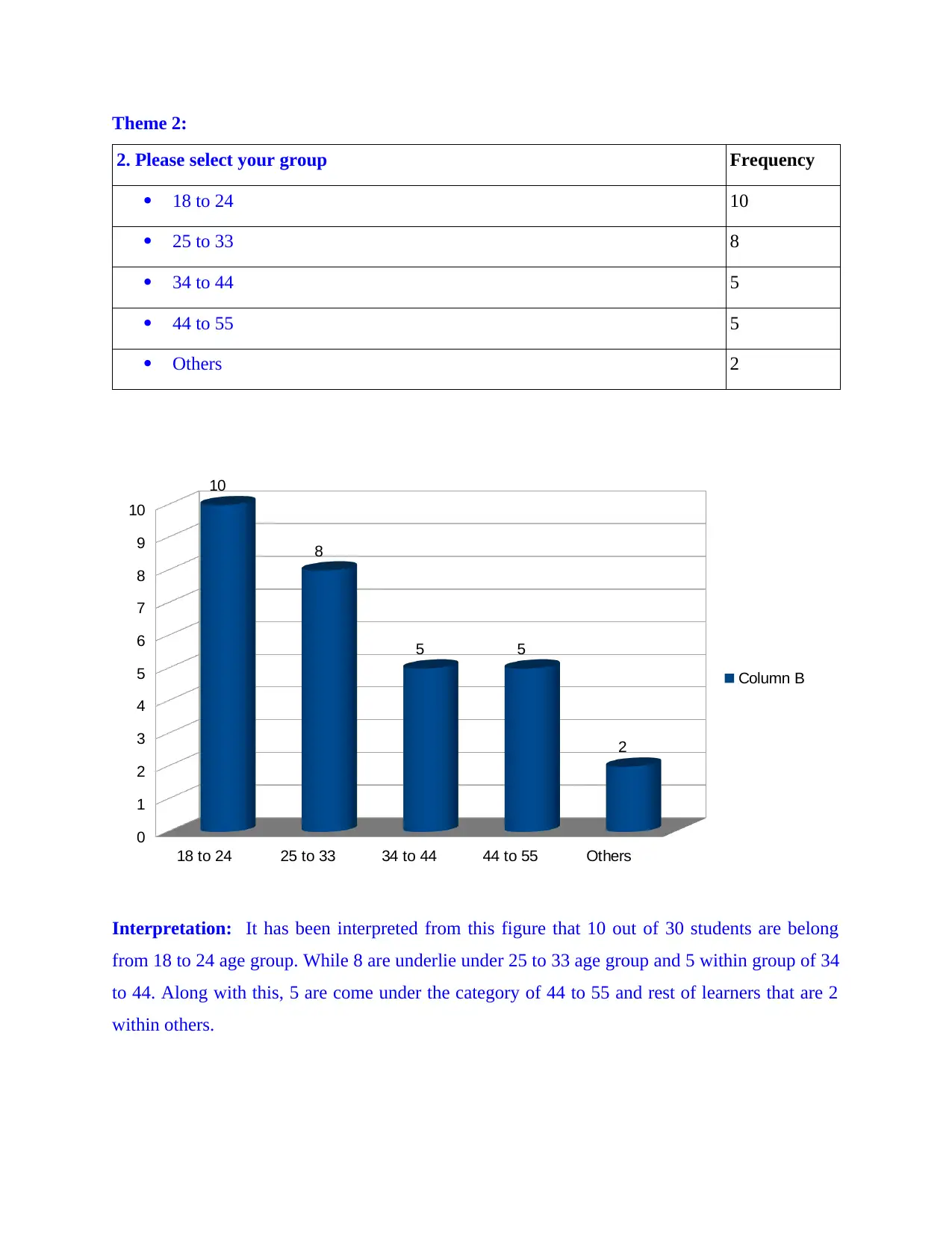
Theme 2:
2. Please select your group Frequency
18 to 24 10
25 to 33 8
34 to 44 5
44 to 55 5
Others 2
Interpretation: It has been interpreted from this figure that 10 out of 30 students are belong
from 18 to 24 age group. While 8 are underlie under 25 to 33 age group and 5 within group of 34
to 44. Along with this, 5 are come under the category of 44 to 55 and rest of learners that are 2
within others.
18 to 24 25 to 33 34 to 44 44 to 55 Others
0
1
2
3
4
5
6
7
8
9
10
10
8
5 5
2
Column B
2. Please select your group Frequency
18 to 24 10
25 to 33 8
34 to 44 5
44 to 55 5
Others 2
Interpretation: It has been interpreted from this figure that 10 out of 30 students are belong
from 18 to 24 age group. While 8 are underlie under 25 to 33 age group and 5 within group of 34
to 44. Along with this, 5 are come under the category of 44 to 55 and rest of learners that are 2
within others.
18 to 24 25 to 33 34 to 44 44 to 55 Others
0
1
2
3
4
5
6
7
8
9
10
10
8
5 5
2
Column B
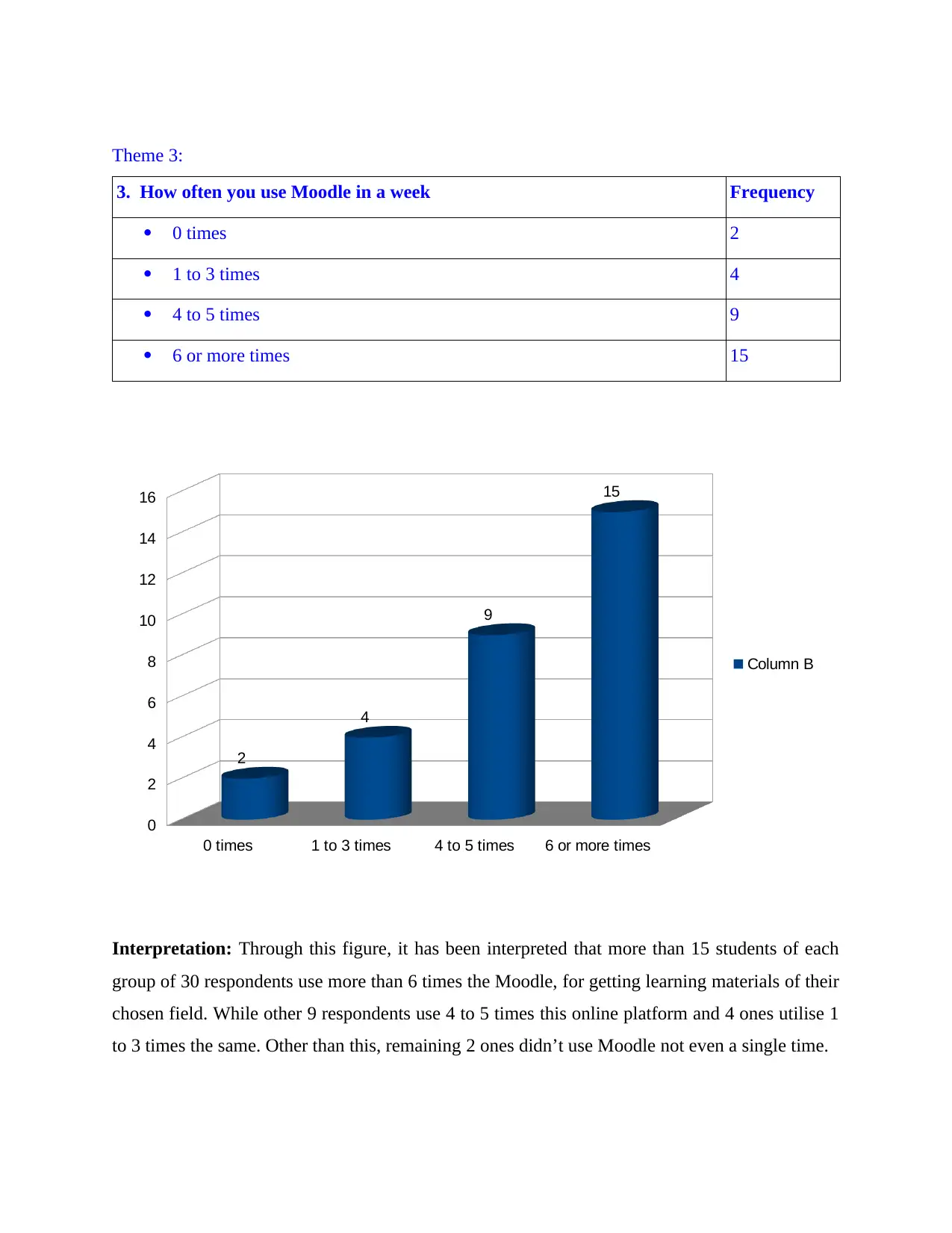
Theme 3:
3. How often you use Moodle in a week Frequency
0 times 2
1 to 3 times 4
4 to 5 times 9
6 or more times 15
Interpretation: Through this figure, it has been interpreted that more than 15 students of each
group of 30 respondents use more than 6 times the Moodle, for getting learning materials of their
chosen field. While other 9 respondents use 4 to 5 times this online platform and 4 ones utilise 1
to 3 times the same. Other than this, remaining 2 ones didn’t use Moodle not even a single time.
0 times 1 to 3 times 4 to 5 times 6 or more times
0
2
4
6
8
10
12
14
16
2
4
9
15
Column B
3. How often you use Moodle in a week Frequency
0 times 2
1 to 3 times 4
4 to 5 times 9
6 or more times 15
Interpretation: Through this figure, it has been interpreted that more than 15 students of each
group of 30 respondents use more than 6 times the Moodle, for getting learning materials of their
chosen field. While other 9 respondents use 4 to 5 times this online platform and 4 ones utilise 1
to 3 times the same. Other than this, remaining 2 ones didn’t use Moodle not even a single time.
0 times 1 to 3 times 4 to 5 times 6 or more times
0
2
4
6
8
10
12
14
16
2
4
9
15
Column B
⊘ This is a preview!⊘
Do you want full access?
Subscribe today to unlock all pages.

Trusted by 1+ million students worldwide
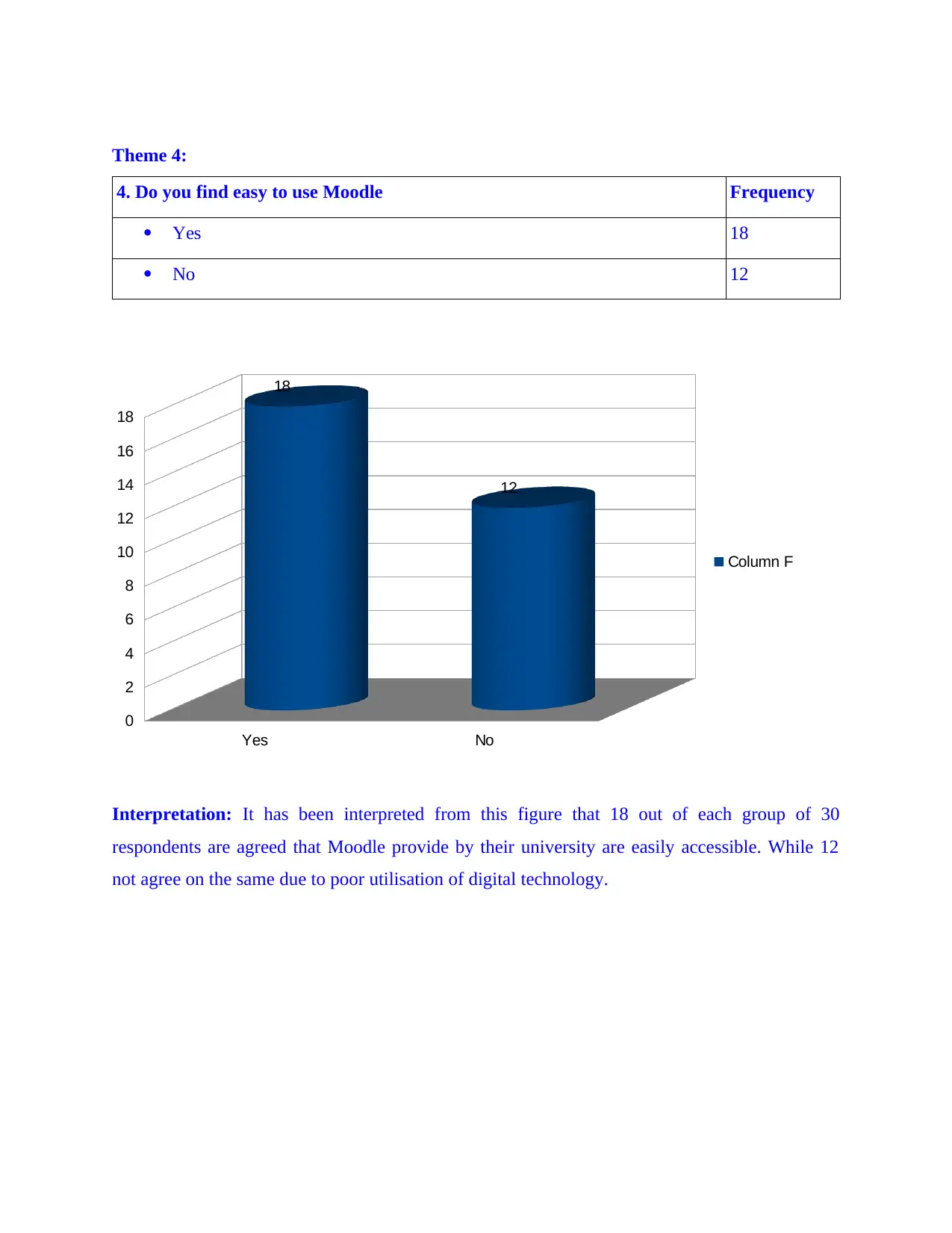
Theme 4:
4. Do you find easy to use Moodle Frequency
Yes 18
No 12
Interpretation: It has been interpreted from this figure that 18 out of each group of 30
respondents are agreed that Moodle provide by their university are easily accessible. While 12
not agree on the same due to poor utilisation of digital technology.
Yes No
0
2
4
6
8
10
12
14
16
18
18
12
Column F
4. Do you find easy to use Moodle Frequency
Yes 18
No 12
Interpretation: It has been interpreted from this figure that 18 out of each group of 30
respondents are agreed that Moodle provide by their university are easily accessible. While 12
not agree on the same due to poor utilisation of digital technology.
Yes No
0
2
4
6
8
10
12
14
16
18
18
12
Column F
Paraphrase This Document
Need a fresh take? Get an instant paraphrase of this document with our AI Paraphraser
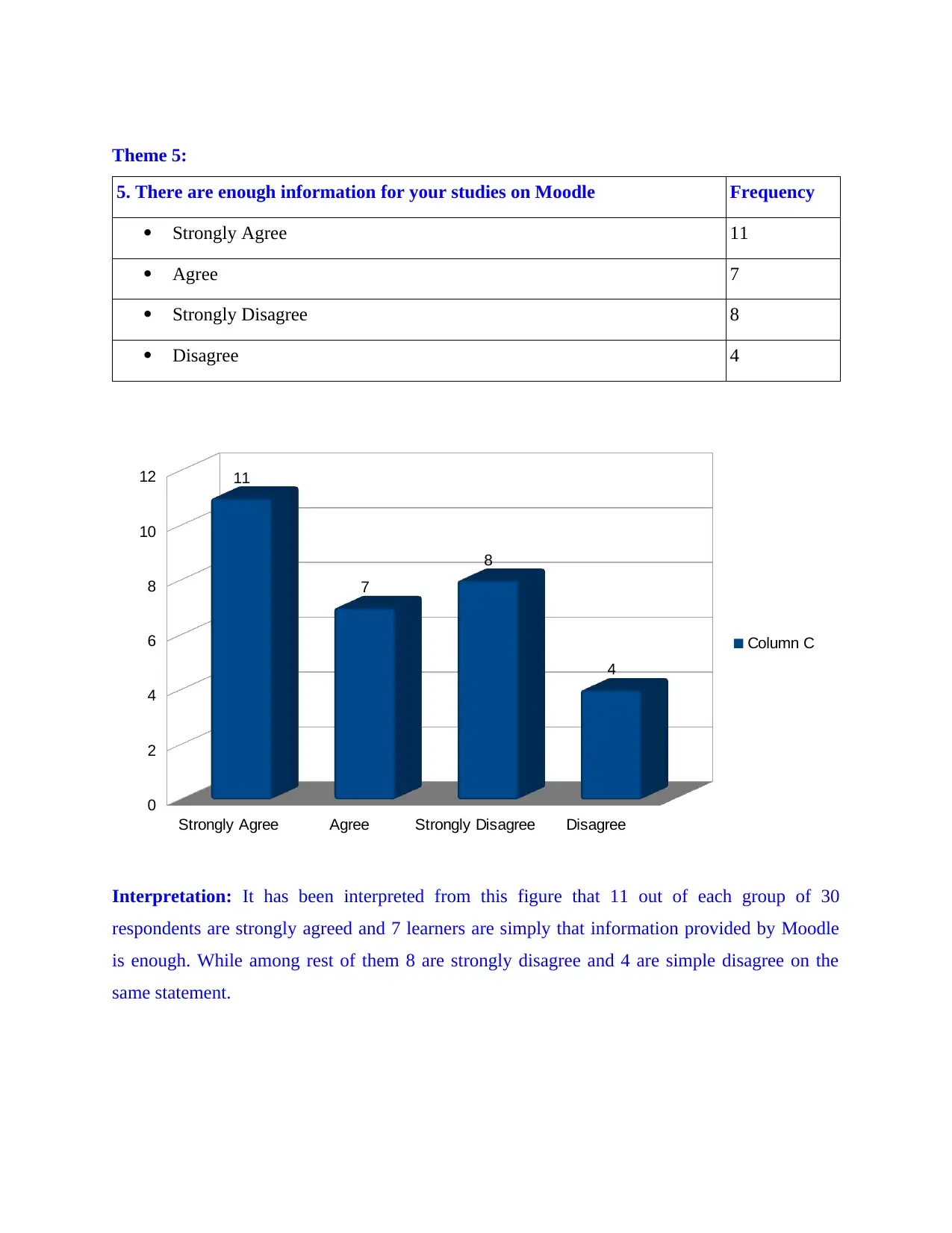
Theme 5:
5. There are enough information for your studies on Moodle Frequency
Strongly Agree 11
Agree 7
Strongly Disagree 8
Disagree 4
Interpretation: It has been interpreted from this figure that 11 out of each group of 30
respondents are strongly agreed and 7 learners are simply that information provided by Moodle
is enough. While among rest of them 8 are strongly disagree and 4 are simple disagree on the
same statement.
Strongly Agree Agree Strongly Disagree Disagree
0
2
4
6
8
10
12 11
7
8
4
Column C
5. There are enough information for your studies on Moodle Frequency
Strongly Agree 11
Agree 7
Strongly Disagree 8
Disagree 4
Interpretation: It has been interpreted from this figure that 11 out of each group of 30
respondents are strongly agreed and 7 learners are simply that information provided by Moodle
is enough. While among rest of them 8 are strongly disagree and 4 are simple disagree on the
same statement.
Strongly Agree Agree Strongly Disagree Disagree
0
2
4
6
8
10
12 11
7
8
4
Column C
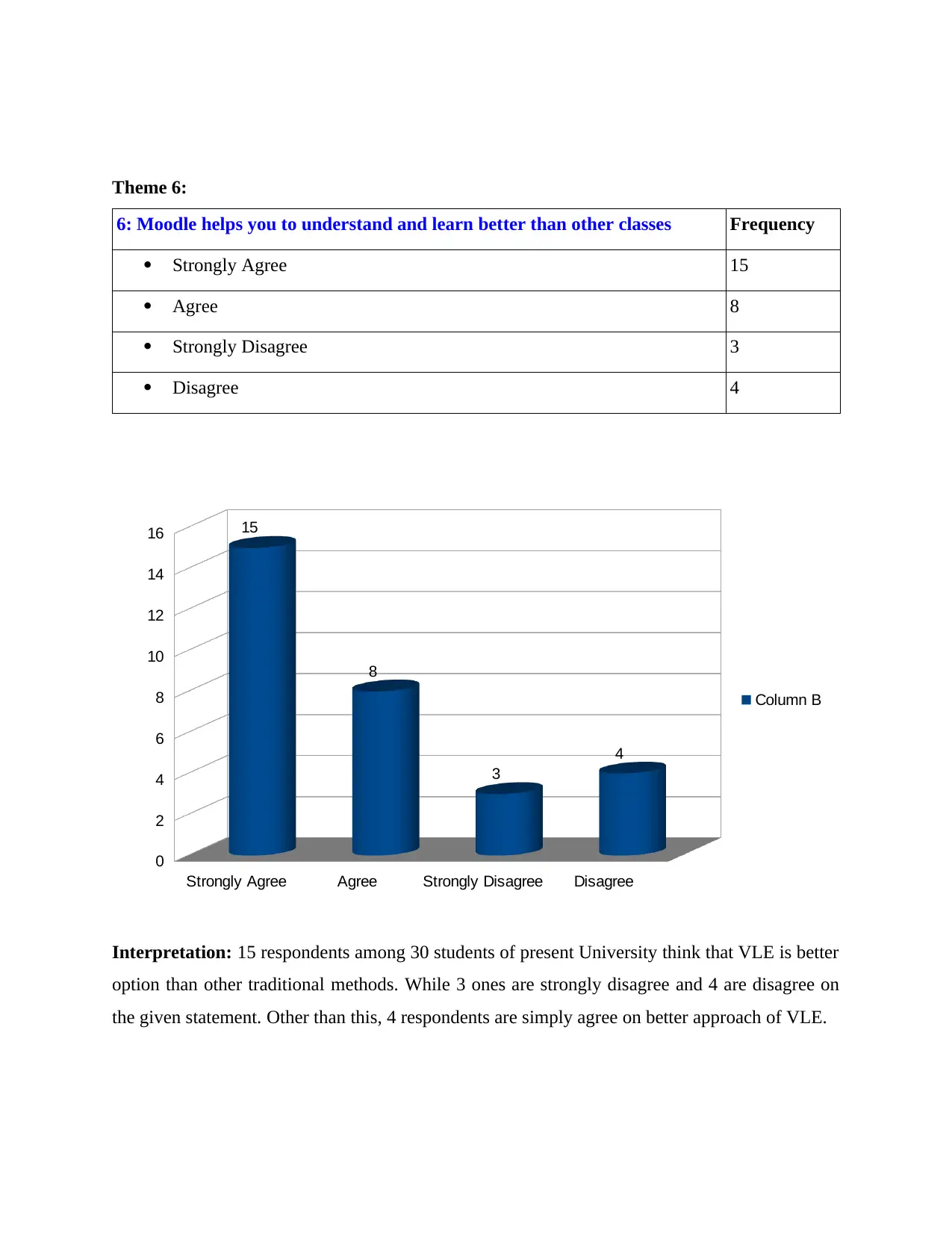
Theme 6:
6: Moodle helps you to understand and learn better than other classes Frequency
Strongly Agree 15
Agree 8
Strongly Disagree 3
Disagree 4
Interpretation: 15 respondents among 30 students of present University think that VLE is better
option than other traditional methods. While 3 ones are strongly disagree and 4 are disagree on
the given statement. Other than this, 4 respondents are simply agree on better approach of VLE.
Strongly Agree Agree Strongly Disagree Disagree
0
2
4
6
8
10
12
14
16 15
8
3
4
Column B
6: Moodle helps you to understand and learn better than other classes Frequency
Strongly Agree 15
Agree 8
Strongly Disagree 3
Disagree 4
Interpretation: 15 respondents among 30 students of present University think that VLE is better
option than other traditional methods. While 3 ones are strongly disagree and 4 are disagree on
the given statement. Other than this, 4 respondents are simply agree on better approach of VLE.
Strongly Agree Agree Strongly Disagree Disagree
0
2
4
6
8
10
12
14
16 15
8
3
4
Column B
⊘ This is a preview!⊘
Do you want full access?
Subscribe today to unlock all pages.

Trusted by 1+ million students worldwide
1 out of 30
Related Documents
Your All-in-One AI-Powered Toolkit for Academic Success.
+13062052269
info@desklib.com
Available 24*7 on WhatsApp / Email
![[object Object]](/_next/static/media/star-bottom.7253800d.svg)
Unlock your academic potential
Copyright © 2020–2025 A2Z Services. All Rights Reserved. Developed and managed by ZUCOL.




